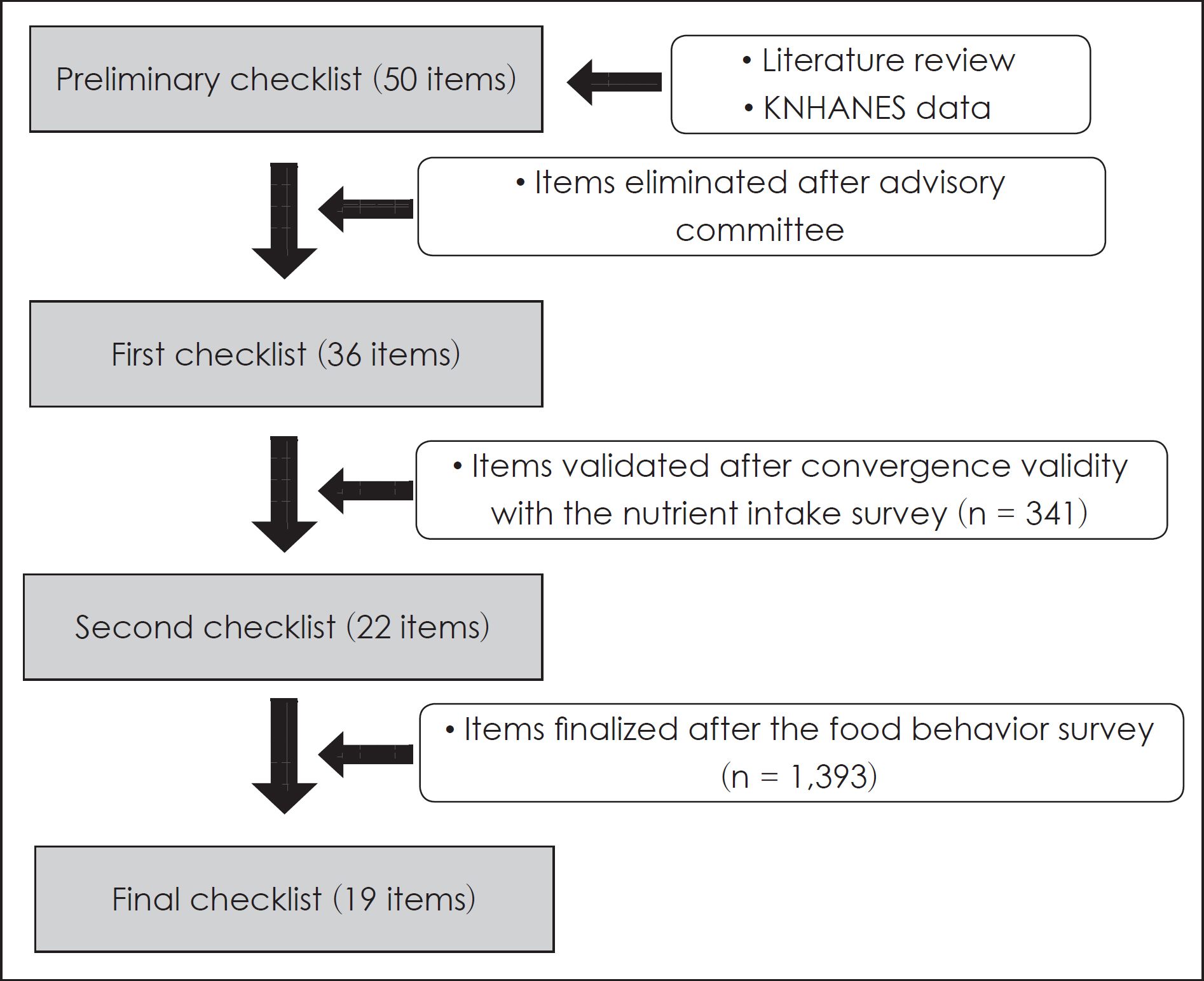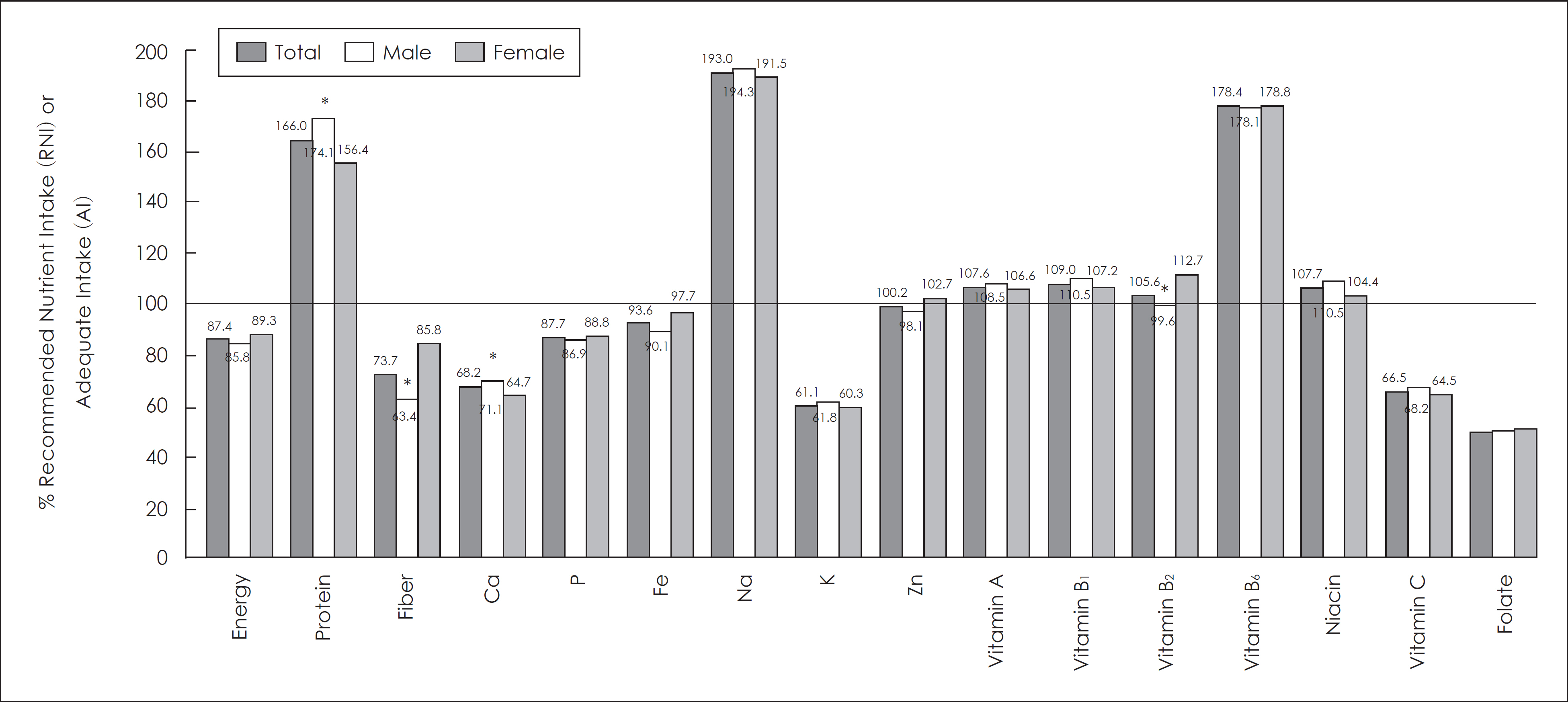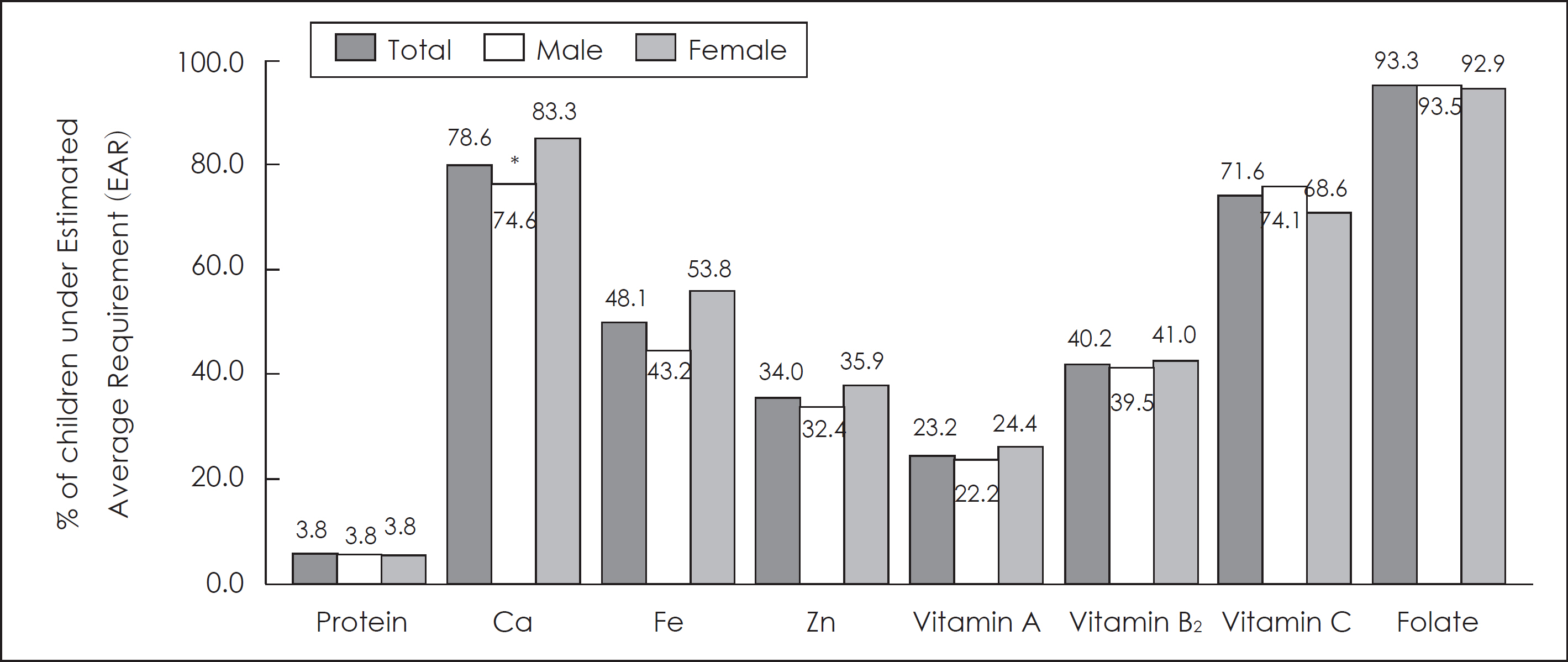Selecting items of a food behavior checklist for the development of Nutrition Quotient (NQ) for children
- Affiliations
-
- 1Department of Food & Nutrition, Daeduk Valley Campus, Hannam University, Daejeon 305-811, Korea. mhkang@hnu.kr
- 2FANSA (Food and Nutrition Statistical Analysis), Seoul 153-764, Korea.
- 3Department of Food & Nutrition, Yongin University, Yongin 449-714, Korea.
- 4Department of Statistics, Hannam University, Daejeon 306-791, Korea.
- 5Department of Food & Nutrition, Daegu University, Daegu 712-714, Korea.
- 6Nutrition for the Future Inc., Seoul 151-848, Korea.
- 7Department of Food & Nutrition, Yonsei University, Seoul 120-749, Korea.
- 8Amway Korea Ltd., Seoul 135-713, Korea.
- KMID: 2268713
- DOI: http://doi.org/10.4163/kjn.2012.45.4.372
Abstract
- The objective of this study is to select a simple and easy measurable food behavior checklist for the development of Nutrition Quotient (NQ) for children, which reflects children's diet quality, as well as to evaluate the validity of the items in the food behavior checklist. The first 36 items in the checklist were established by an expert review, modifying the preliminary 50 items in the checklist, which had been selected by a literature review and the Korean National Health and Nutrition Examination Survey data. 341 children in 5th and 6th grades at an elementary school participated in a one-day dietary record survey, and later responded to 36 food behavior questions of the checklist. Pearson's correlation coefficients between the responses to the food behavior checklist items along with the mean nutrient intakes of the children were calculated. From the result, in which responses of food frequency and food behavior items showed certain association with the dietary record data, a second checklist with 22 items was selected. A survey was conducted by using the second checklist. 1,393 children in the 5th and 6th grades at 12 elementary schools in metropolitan cities, such as Seoul, Busan, Gwangju, Daegu, Daejeon, and Incheon, participated in the survey. Further, an exploratory factor analysis was performed. After the analysis, 19 items (10 items from food frequency and 9 items from food behavior) were finalized as the food behavior checklist items for the NQ. The final 19 food behavior checklist items were composed of 5 factors: 'Balance', 'Diversity', 'Moderation', 'Regularity', and 'Practice'. This study is a significant first trial to establish a comprehensive system for evaluating children's food habit and diet quality. This checklist might need continuous modification and revision reflecting the change of children's dietary life and the social environment.
Figure
Cited by 17 articles
-
Relationships between Obesity and Dietary Habits of Preschool Children and Their Parents in Dongducheon Based on the Nutrition Quotient (NQ)
Ji-Myung Kim, Hye Jeong Song, Young Ji Ahn
Korean J Community Nutr. 2018;23(3):216-225. doi: 10.5720/kjcn.2018.23.3.216.Development of a Nutrition Quotient (NQ) equation modeling for children and the evaluation of its construct validity
Hye-Young Kim, Sehyug Kwon, Jung-Sug Lee, Young-Sun Choi, Hae Rang Chung, Tong-Kyung Kwak, Juyeon Park, Myung-Hee Kang
Korean J Nutr. 2012;45(4):390-399. doi: 10.4163/kjn.2012.45.4.390.Child health promotion program in South Korea in collaboration with US National Aeronautics and Space Administration: Improvement in dietary and nutrition knowledge of young children
Hyunjung Lim, JiEun Kim, Youfa Wang, Jungwon Min, Nubia A. Carvajal, Charles W. Lloyd
Nutr Res Pract. 2016;10(5):555-562. doi: 10.4162/nrp.2016.10.5.555.Development of tailored nutrition information messages based on the transtheoretical model for smartphone application of an obesity prevention and management program for elementary-school students
Ji Eun Lee, Da Eun Lee, Kirang Kim, Jae Eun Shim, Eunju Sung, Jae-Heon Kang, Ji-Yun Hwang
Nutr Res Pract. 2017;11(3):247-256. doi: 10.4162/nrp.2017.11.3.247.Exploring parenting variables associated with sweetness preferences and sweets intake of children
Taejung Woo, Kyung-Hea Lee
Nutr Res Pract. 2019;13(2):169-177. doi: 10.4162/nrp.2019.13.2.169.Evaluation of the diet and nutritional states of elementary and middle school students in the Daegu area by using nutrition quotient for children
Su Jung Lee, Youngnam Kim
J Nutr Health. 2013;46(5):440-446. doi: 10.4163/jnh.2013.46.5.440.Evaluation of items for the food behavior checklist and nutrition quotient score on children in rural areas of Gyeongbuk
Jung-Sun Yoo, Young-Sun Choi
J Nutr Health. 2013;46(5):427-439. doi: 10.4163/jnh.2013.46.5.427.Relationships between children's Nutrition Quotient and the practice of the Dietary Guidelines of elementary school students and their mothers
Jae Ran Kim, Hyeon-Sook Lim
J Nutr Health. 2015;48(1):58-70. doi: 10.4163/jnh.2015.48.1.58.Development of nutrition quotient for Korean preschoolers (NQ-P): Item selection and validation of factor structure
Jung-Sug Lee, Myung-Hee Kang, Tong-Kyung Kwak, Hae Rang Chung, Sehyug Kwon, Hye-Young Kim, Ji-Yun Hwang, Young-Sun Choi
J Nutr Health. 2016;49(5):378-394. doi: 10.4163/jnh.2016.49.5.378.Age difference in association between obesity and Nutrition Quotient scores of preschoolers and school children
Joo-Mee Bae, Myung-Hee Kang
J Nutr Health. 2016;49(6):447-458. doi: 10.4163/jnh.2016.49.6.447.Development of NQ-A, Nutrition Quotient for Korean Adolescents, to assess dietary quality and food behavior
Hye-Young Kim, Jung-Sug Lee, Ji-Yun Hwang, Sehyug Kwon, Hae Rang Chung, Tong-Kyung Kwak, Myung-Hee Kang, Young-Sun Choi
J Nutr Health. 2017;50(2):142-157. doi: 10.4163/jnh.2017.50.2.142.Development of Nutrition Quotient for Korean adults: item selection and validation of factor structure
Jung-Sug Lee, Hye-Young Kim, Ji-Yun Hwang, Sehyug Kwon, Hae Rang Chung, Tong-Kyung Kwak, Myung-Hee Kang, Young-Sun Choi
J Nutr Health. 2018;51(4):340-356. doi: 10.4163/jnh.2018.51.4.340.Analysis of the types of eating behavior affecting the nutrition of preschool children: using the Dietary Behavior Test (DBT) and the Nutrition Quotient (NQ)
Hyeon Mi Sim, Youngshin Han, Kyung A Lee
J Nutr Health. 2019;52(6):604-617. doi: 10.4163/jnh.2019.52.6.604.Evaluation of dietary behavior and nutritional status of elementary school students in Jeju using nutrition quotient
∗
Mi Na Boo, Su Kyung Cho, Kyong Park
J Nutr Health. 2015;48(4):335-343. doi: 10.4163/jnh.2015.48.4.235.Assessment of dietary behavior of Chinese children using nutrition quotient for children
Yi-Chun Huang, Hye-Young Kim
J Nutr Health. 2014;47(5):342-350. doi: 10.4163/jnh.2014.47.5.342.Development of NQ-E, Nutrition Quotient for Korean elderly: item selection and validation of factor structure
∗
Min-Jae Chung, Kwak Tong-Kyung, Hye-Young Kim, Myung-Hee Kang, Jung-Sug Lee, Hae Rang Chung, Sehyug Kwon, Ji-Yun Hwang, Young-Sun Choi
J Nutr Health. 2018;51(1):87-102. doi: 10.4163/jnh.2018.51.1.87.Evaluation of Food Behavior and Nutritional Status of Preschool Children in Nowon-gu of Seoul by Using Nutrition Quotient (NQ)
Jung Hee Kim, Yeon Hyang Jung
Korean J Community Nutr. 2014;19(1):1-11. doi: 10.5720/kjcn.2014.19.1.1.
Reference
-
1). Lee JS, Kim HY, Choi YS, Kwak TK, Chung HR, Kwon S, Choi YJ, Lee SK, Kang MH. Comparison of perception and practice levels of dietary life in elementary school children according to gender and obesity status. Korean J Nutr. 2011; 44(6):527–536.
Article2). Ministry of Health and Welfare, Korea Centers for Disease Control and Prevention. The fourth Korea National Health and Nutrition Examination Survey report (KNHANES IV-3). 2010.3). Kant AK. Indexes of overall diet quality: a review. J Am Diet Assoc. 1996; 96(8):785–791.4). Kant AK. Dietary patterns and health outcomes. J Am Diet Assoc. 2004; 104(4):615–635.
Article5). Michels KB, Schulze MB. Can dietary patterns help us detect diet-disease associations? Nutr Res Rev. 2005; 18(2):241–248.
Article6). Patterson RE, Haines PS, Popkin BM. Diet quality index: capturing a multidimensional behavior. J Am Diet Assoc. 1994; 94(1):57–64.
Article7). Kennedy ET, Ohls J, Carlson S, Fleming K. The Healthy Eating Index: design and applications. J Am Diet Assoc. 1995; 95(10):1103–1108.8). Haines PS, Siega-Riz AM, Popkin BM. The Diet Quality Index revised: a measurement instrument for populations. J Am Diet Assoc. 1999; 99(6):697–704.9). Guenther PM, Reedy J, Krebs-Smith SM, Reeve BB, Basiotis PP. Development and evaluation of the healthy eating index-2005. Technical report. Center for Nutrition Policy and Promotion, U.S. Department of Agriculture. Alexandria (VA). 2007.10). Serra-Majem L, Ribas L, Ngo J, Ortega RM, García A, Pérez-Rodrigo C, Aranceta J. Food, youth and the Mediterranean diet in Spain. Development of KIDMED, Mediterranean Diet Quality Index in children and adolescents. Public Health Nutr. 2004; 7(7):931–935.
Article11). Blackburn ML, Townsend MS, Kaiser LL, Martin AC, West EA, Turner B, Joy AB. Food behavior checklist effectively evaluates nutrition education. Calif Agric. 2006; 60(1):20–24.
Article12). Townsend MS, Kaiser LL, Allen LH, Joy AB, Murphy SP. Selecting items for a food behavior checklist for a limited-resource audience. J Nutr Educ Behav. 2003; 35(2):69–77.
Article13). Branscum P, Sharma M, Kaye G, Succop P. An evaluation of the validity and reliability of a food behavior checklist modified for children. J Nutr Educ Behav. 2010; 42(5):349–352.
Article14). Kim KN, Hyun T, Lee JW. Development of a simple screening test for identifying Korean elderly at risk of undernutrition. Korean J Community Nutr. 2000; 5(3):475–483.15). Park YS, Han JL, Lee JW, Cho HS, Koo J, Kim JH, Yoon JS. The development of a simple evaluation questionnaire for screening the overweight-type dietary pattern in 30 to 49 year old adults. Korean J Community Nutr. 2002; 7(4):495–505.16). Park YS, Lee JW. Development of a simple evaluation questionnaire for screening the dietary patterns of overweight young adults. Korean J Community Nutr. 2002; 7(5):675–685.17). Park JA, Yoon JS. A screening tool for identifying high-risk pregnant women of Fe deficiency anemia: Process I. Korean J Community Nutr. 2001; 6(5):734–743.18). Park JA, Yoon JS. A screening tool for identifying high-risk pregnant women of Fe deficiency anemia: Process II. Korean J Community Nutr. 2003; 8(2):160–170.19). Yon M, Hyun T. Development of an eating habit checklist for screening elementary school children at high risk of energy over-intake. Korean J Nutr. 2008; 41(5):414–427.20). Yon M, Hyun T. Development of an eating habit checklist for screening elementary school children at risk of inadequate micronutrient intake. Korean J Nutr. 2009; 42(1):38–47.21). Kang MH, Kwak TK, Choi YS, Chung HR, Kim HY, Lee JS, Yi NY, Choi JH. Production and evaluation of safety index for children’s dietary life. KFDA report. 2009.22). Ministry of Health and Welfare. Dietary guidelines leaflet for Korean. Seoul. 2009.23). Feskanich D, Rockett HR, Colditz GA. Modifying the Healthy Eating Index to assess diet quality in children and adolescents. J Am Diet Assoc. 2004; 104(9):1375–1383.
Article24). Kim JA, Lee SY. Nutritional evaluation of served menu in Korean temples. Korean J Nutr. 2007; 40(2):172–181.25). The Korean Nutrition Society. Dietary reference intakes for Koreans. Seoul. 2010.26). Lee RD, Nieman DC. Nutritional assessment. 4th ed.Boston: McGraw-Hill;2007.27). Lazarou C, Newby PK. Use of dietary indexes among children in developed countries. Adv Nutr. 2011; 2(4):295–303.
Article28). Kourlaba G, Panagiotakos D. The number of index components affects the diagnostic accuracy of a diet quality index: the role of intracorrelation and intercorrelation structure of the components. Ann Epidemiol. 2009; 19(10):692–700.
Article29). Kourlaba G, Panagiotakos D. The diagnostic accuracy of a composite index increases as the number of partitions of the components increases and when specific weights are assigned to each component. J Appl Stat. 2010; 37(4):537–554.
Article30). Murphy SP, Kaiser LL, Townsend MS, Allen LH. Evaluation of validity of items for a food behavior checklist. J Am Diet Assoc. 2001; 101(7):751–761.
Article31). Taylor JP, Evers S, McKenna M. Determinants of healthy eating in children and youth. Can J Public Health. 2005; 96(Suppl 3):S20-S26, S22-S29.32). Davis MM, Gance-Cleveland B, Hassink S, Johnson R, Paradis G, Resnicow K. Recommendations for prevention of childhood obesity. Pediatrics. 2007; 120(Suppl 4):S229-S253.
Article33). Hurley KM, Oberlander SE, Merry BC, Wrobleski MM, Klassen AC, Black MM. The healthy eating index and youth healthy eating index are unique, nonredundant measures of diet quality among low-income, African American adolescents. J Nutr. 2009; 139(2):359–364.
Article
- Full Text Links
- Actions
-
Cited
- CITED
-
- Close
- Share
- Similar articles
-
- Selecting items of a food behavior checklist for the development of Nutrition Quotient (NQ) for children
- Development of NQ-E, Nutrition Quotient for Korean elderly: item selection and validation of factor structure
- Revision of Nutrition Quotient for Korean adults: NQ-2021
- Development of NQ-A, Nutrition Quotient for Korean Adolescents, to assess dietary quality and food behavior
- Revision of Nutrition Quotient for Korean adolescents 2021 (NQ-A 2021)





